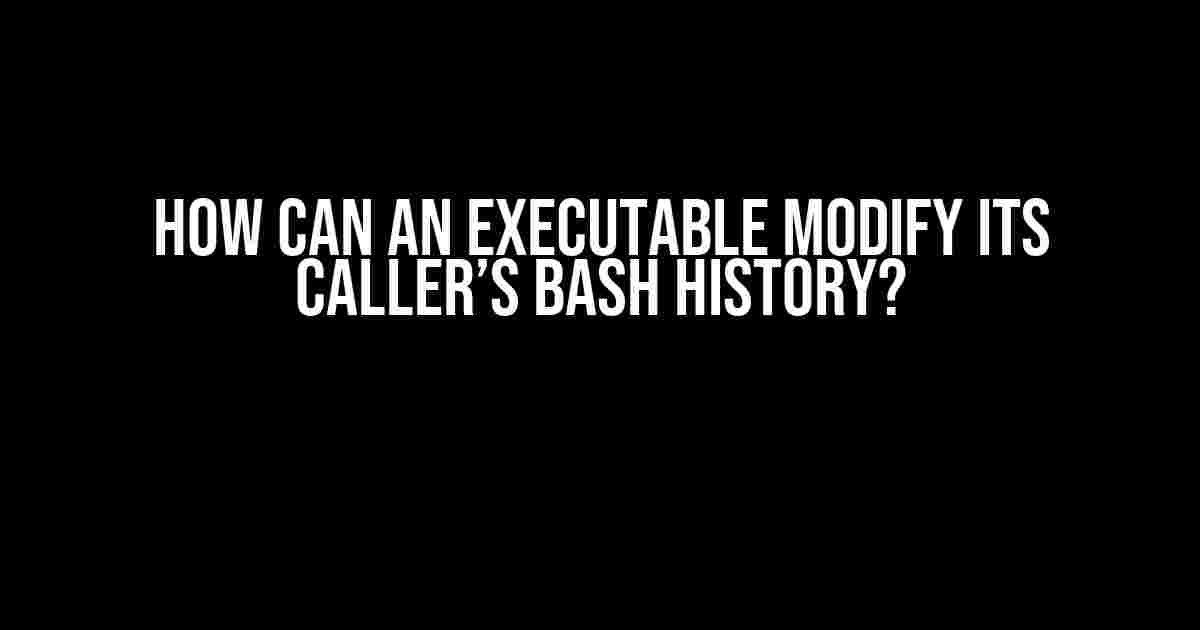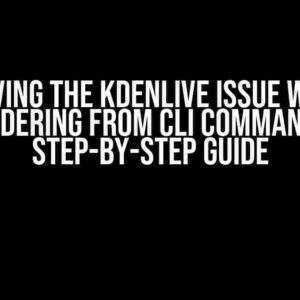Have you ever wondered how some executables can sneakily modify your bash history? Maybe you’ve stumbled upon a fascinating tool that can alter your command history, leaving you curious about the magic behind it. In this article, we’ll delve into the world of executable wizardry and explore how they can indeed modify their caller’s bash history.
Understanding Bash History
Before we dive into the juicy stuff, let’s quickly review how bash history works. When you use the command line, your shell (in this case, bash) keeps a record of your commands in a file called `.bash_history`. This file stores a list of your previous commands, allowing you to recall and reuse them later. By default, bash stores the last 500 commands in this file.
How Bash History Files Work
Bash history files are stored in your home directory, and their location can be found by running the command `echo $HISTFILE`. Typically, this file is located at `~/.bash_history`. When you exit a shell session, bash writes the current command history to this file. The next time you start a new shell session, bash reads from this file and loads the command history into memory.
The Magic of Executable Modification
Now that we’ve covered the basics of bash history, let’s explore how executables can modify this history. To achieve this, an executable needs to manipulate the contents of the `.bash_history` file or the shell’s in-memory command history. Here are the ways an executable can modify its caller’s bash history:
Method 1: Writing to the History File Directly
One way an executable can modify the bash history is by directly writing to the `.bash_history` file. This method is straightforward but requires careful attention to avoid overwriting or corrupting the file. The executable can use standard file I/O operations to append or modify the contents of the file.
#!/bin/bash
# Append a new command to the history file
echo "ls -l" >> ~/.bash_history
Method 2: Using the `history` Command
The `history` command allows an executable to manipulate the shell’s in-memory command history. By using this command, an executable can add, delete, or modify commands in the history. To use this method, the executable needs to spawn a new shell process and execute the `history` command within that shell.
#!/bin/bash
# Add a new command to the history
history -s "ls -l"
# Delete the last command from the history
history -d $((HISTCMD-1))
Method 3: Using Environment Variables
Bash provides environment variables that allow an executable to influence the shell’s behavior. By setting specific environment variables, an executable can modify the bash history. For example, the `HISTFILE` variable controls the location of the history file, and the `HISTSIZE` variable sets the maximum number of commands to store in the history.
#!/bin/bash
# Set the history file location
export HISTFILE=~/.custom_history
# Set the maximum history size
export HISTSIZE=1000
Security Implications
While modifying bash history might seem harmless, it raises significant security concerns. An executable with the ability to modify its caller’s bash history can:
- Potentially inject malicious commands into the history, which could be executed unintentionally.
- Steal sensitive information, such as passwords or API keys, by modifying history entries to capture input.
- Compromise system security by altering audit trails or hiding evidence of malicious activities.
It’s essential to exercise caution when granting executables permission to modify bash history and to ensure that such executables come from trusted sources.
Best Practices for Modifying Bash History
If you’re developing an executable that needs to modify bash history, follow these best practices to minimize security risks:
- Use secure methods: Favor using the `history` command over direct file manipulation to avoid potential file corruption.
- Validate input: Sanitize user input to prevent injection attacks or sensitive information disclosure.
- Limit privileges: Run your executable with minimal privileges to reduce the attack surface.
- Audit trails: Keep a record of modifications made to the bash history to maintain accountability.
Conclusion
In this article, we’ve explored the fascinating world of executable magic, where programs can modify their caller’s bash history. We’ve covered the different methods executables can use to achieve this, including writing to the history file directly, using the `history` command, and manipulating environment variables. However, we’ve also highlighted the potential security risks involved and stressed the importance of following best practices to minimize these risks. By understanding how executables can modify bash history, you’ll be better equipped to develop secure and responsible software.
| Method | Description | Risk Level |
|---|---|---|
| Direct File Manipulation | Writes to the .bash_history file directly | High |
| Using the `history` Command | Manipulates the shell’s in-memory command history | Medium |
| Environment Variables | Modifies environment variables to influence bash behavior | Low |
Remember, with great power comes great responsibility. Use your newfound knowledge wisely and always prioritize security when developing executables that modify bash history.
Frequently Asked Question
Are you curious about how an executable can modify its caller’s bash history? Let’s dive into the world of Linux and explore the possibilities!
Can an executable really modify its caller’s bash history?
Yes, it is indeed possible for an executable to modify its caller’s bash history. This can be achieved through a variety of methods, including writing to the history file, manipulating the readline library, or even exploiting vulnerabilities in the shell itself. However, it’s important to note that such actions typically require elevated privileges and careful manipulation of system resources.
How does an executable access its caller’s bash history?
An executable can access its caller’s bash history by reading the contents of the ~/.bash_history file, which stores the user’s command history. However, this file is typically only readable by the owner, so the executable would need to be run with the same privileges as the user or have elevated access to read the file. Alternatively, an executable could also use system calls to access the shell’s history buffer directly.
What kind of modifications can an executable make to its caller’s bash history?
An executable can make various modifications to its caller’s bash history, including adding, removing, or modifying existing commands. It could also alter the timestamp or order of the commands, or even inject malicious commands into the history. The possibilities are endless, and it’s up to the executable’s developer to decide how to manipulate the history.
Are there any security implications to an executable modifying its caller’s bash history?
Absolutely! Allowing an executable to modify its caller’s bash history can have serious security implications. Malicious actors could use this capability to inject malicious commands, steal sensitive information, or even take control of the system. It’s essential to be cautious when granting executables access to system resources and to carefully review their permissions and behavior.
How can I prevent an executable from modifying my bash history?
To prevent an executable from modifying your bash history, you can take several precautions. Firstly, always run executables with the least privileges necessary. Secondly, restrict access to the ~/.bash_history file by setting proper permissions. Finally, be cautious when installing software from untrusted sources, and thoroughly review the executable’s behavior and permissions before running it.


